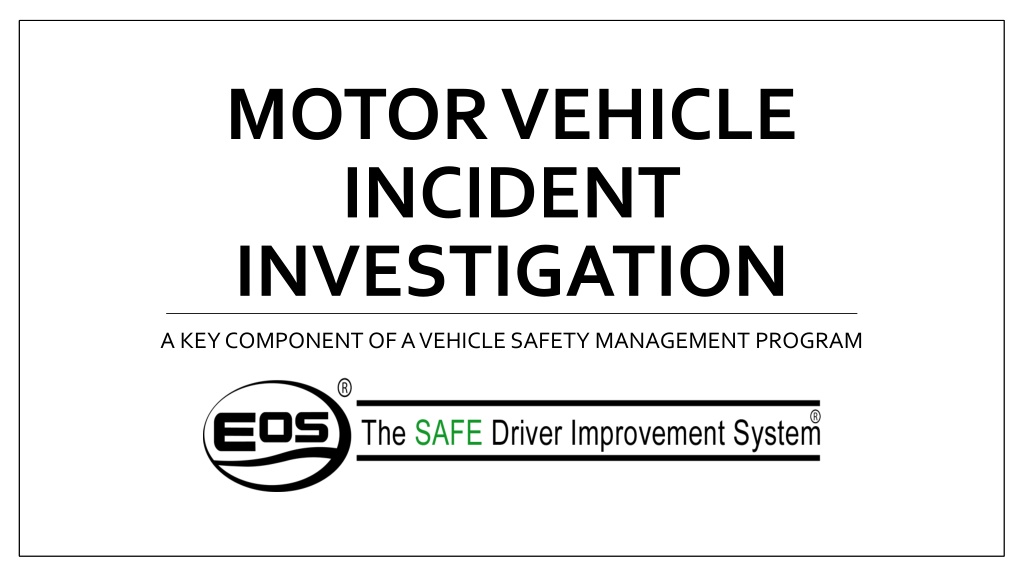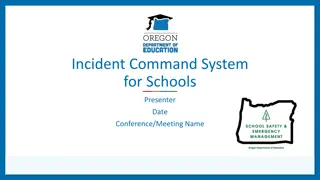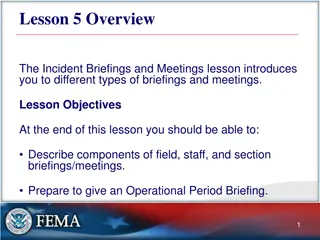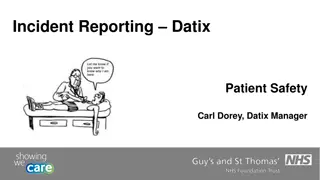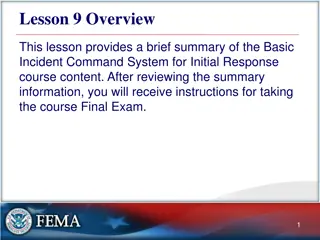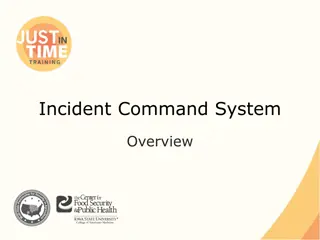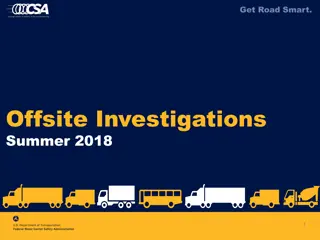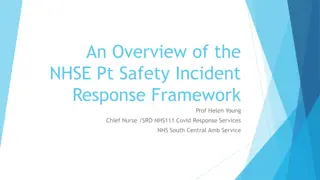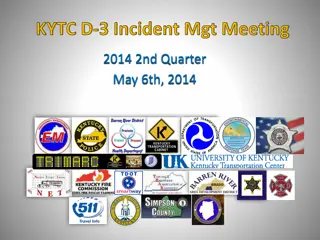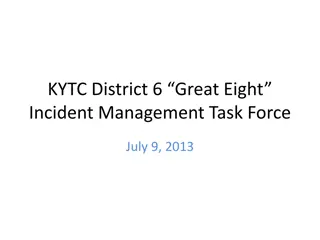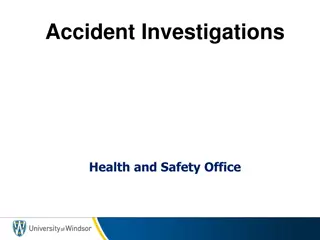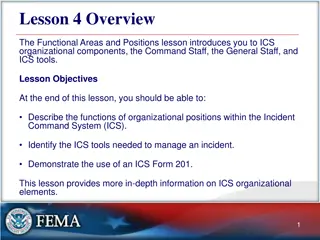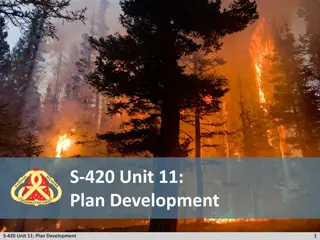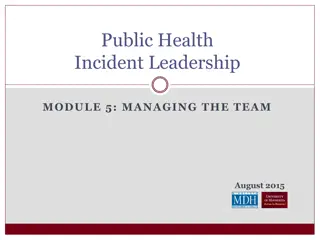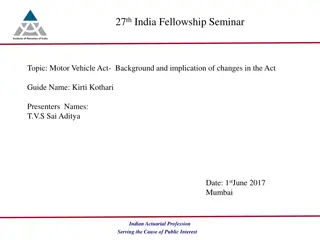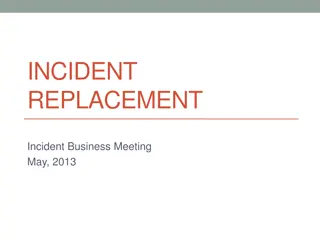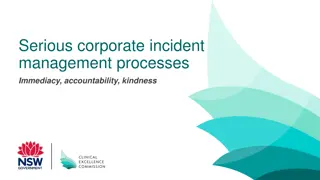Understanding Motor Vehicle Incident Investigations for Vehicle Safety Management
Motor Vehicle Incident Investigations (MVI) are a crucial component of a vehicle safety management program. This comprehensive guide explores the definition of MVIs, why they are distinct from accidents, severity levels, investigation steps, causes of crashes, and the Swiss Cheese Model of human error in accidents.
Download Presentation

Please find below an Image/Link to download the presentation.
The content on the website is provided AS IS for your information and personal use only. It may not be sold, licensed, or shared on other websites without obtaining consent from the author. Download presentation by click this link. If you encounter any issues during the download, it is possible that the publisher has removed the file from their server.
E N D
Presentation Transcript
MOTOR VEHICLE INCIDENT INVESTIGATION A KEY COMPONENT OF A VEHICLE SAFETY MANAGEMENT PROGRAM
What is a motor vehicle incident? (MVI) Several common terms Traffic accident Vehicle collision Crash Wreck They all mean the same thing
Definition of MVI An incident involving a motor vehicle when the vehicle contacts Another motor vehicle Fixed object Road debris Pedestrian or bicyclist Animal OR When the vehicle inadvertently departs the intended path of travel on any axis.
Definition of MVI Typically does not include Vehicle is hit by another vehicle while legally parked Damage when loading or unloading the vehicle Injuries while entering or exiting the parked vehicle Weather-related damage, parked or driving Superficial damage while driving, such as rock chips Vandalism
Why incident? Incident v. Accident Accident implies an unexpected event which defies cause identification.
MVI severity Catastrophic Fatality Major Any vehicle occupant receives medical attention away from the scene Any vehicle rollover Serious Any involved vehicle towed from the scene Minor
MVI Investigation A cog in the wheel Vehicle Safety Management Cycle MVI Management Steps taken after an MVI, including: Driver reporting procedures MVI investigation Determining preventability Tracking data Identifying gaps in the vehicle safety management cycle
Crash Causes Accidents of all types rarely have only one cause Multiple failures of barriers Two categories: Causal factors Root cause If root cause is eliminated, chance of reoccurrence diminishes
James Reasons Swiss Cheese Model
Why investigate? Law enforcement Insurance investigators/adjusters Attorneys Traffic engineers National Transportation Safety Board (NTSB) Vehicle designers and safety engineers
Why do we investigate? To ensure accurate data is collected and retained To satisfy insurance and/or regulatory requirements But perhaps more importantly Uncover the root causes of our MVIs Determine preventability Identify and close gaps in the vehicle safety management cycle
Who investigates? Select an investigation team Staff safety professional(s) Supervisor Manager Fleet Manager Legal counsel for catastrophic MVIs
Investigation levels Which MVIs should we investigate? ALL of them! But to what extent? Investigate to the extent of existing company polices, driver qualification standards, and driver training programs, and Decide how far to go depending on severity.
Before the MVI Find a good MVI reporting form and make sure a blank one is in every vehicle Find a MVI quick reference card and make sure a copy is in every vehicle Steps to take What not to say How to take photos Who to call Insurance carrier requirements Drivers trained in what to do
During a MVI Report all MVIs involving third parties to the police regardless of severity Driver calls supervisor and follows QRC Insurance requirements are followed
Collecting data Driver s MVI report and photos Vehicle telematics data Driver s most recent MVR Cell phone records Run a new MVR if needed Police report Driver s training records Printout of location map Past MVI reports involving the driver Google Street photos of area, if available Past notifications of traffic violations If traffic cameras are used in the area, request footage from the operator Vehicle maintenance records
Employee interview Consult HR professionals Interview as soon as possible, but Allow time to let nerves settle If employee was injured, wait a prudent amount of time Don t rely solely on the employee s description on the MVI report Reassure the reasons of the interview Don t let an admission of fault derail the investigation
Witness interviews Only if necessary For catastrophic MVIs, let legal counsel interview them For others, ask what they remember and take notes Use statements to narrow down exactly what happened
Investigation findings What happened? Why did it happen? What was the root cause? What can be changed in the vehicle safety management cycle?
Closing the investigation Written report with MVI details Investigation team Narrative of events Facts derived from data Causal factors Root cause Preventability Recommendations of changes to the vehicle safety management cycle Enter data into a trackable database Type of MVI backing, intersection, sideswipe, head-on, rear end, fixed object, etc. Vehicle type
THANK YOU! Please contact Chris Freedom for more support regarding Incident Investigations or anything Driver Safety related. 1-844-4 EOS SAFE
